
Put on your aprons and dancing shoes, it’s time to SALSA!
So pleased to see another yummy book in Jorge Argueta’s popular bilingual Cooking Poem Series. Previously, Jorge treated us to Sopa de frijoles/Bean Soup (2009), Arroz con leche/Rice Pudding (2010), Guacamole (2012), and Tamalitos (2013). Mmmmm!
Now, with Salsa (Groundwood Books, 2015), illustrated by Pura Belpré winner Duncan Tonatiuh, Argueta infuses his lyrical, lip-smacking recipe with savory musical instruments, lively rhythms, a wealth of sensory details, and just the right amount of spice to make readers crave more.

A young boy first describes the molcajete, a type of stone bowl dating back to the time of the ancient Aztec, Mayan, and Nahua peoples used to grind tomatoes, corn, chilies, vegetables and spices. He mentions how every weekend his family uses their molcajete to make salsa while they sing and dance.
Before proceeding, he and his sister “play” the ingredients from their very own “salsa orchestra”:
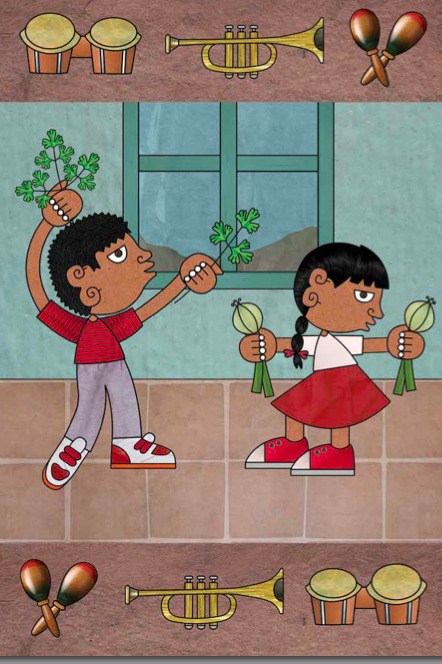
I am ready with four tomatoes.
They are bongos and kettledrums.
My onion is a maraca.
Cloves of garlic are trumpets,
and the cilantro is the orchestra conductor
with his shaggy, green hair.
*
Ya tengo listos cuatro tomates.
Son bongos y timbales.
La cebolla es una maraca.
Los ajos son trompetas,
y el cilantro un director de orquesta
con su pelo verde todo despeinado.
Then come praises for colorful, hot chilies to make the “music” spicy. The boy feels like he’s “dancing among rainbows and stars.”

There are hot green chilies.
One bite and we turn into fireflies,
flashing on and off.
There are chilies with faces like a grandfather
and chilies with faces like a grandmother.
There are red chilies
like little flames.
When we bite one our tongue gets hot,
as if we had a tiny light on in our mouth.
There are purple chilies
that look like they swallowed the sunset,
yellow chilies like drops of honey
and even little round chilies like green pearls.
*
Hay chiles verdes.
Al morderlos nos apagamos y encendemos
como si fuéramos luciérnagas.
Hay chiles con cara de abuelo
y chiles con cara de abuela.
Hay chiles rojos
como llamitas.
Al morderlos nos calientan la lengua
como si tuviéramos en la boca una lucecita.
Hay chiles morados
como si se hubieran tragado un atardecer,
chiles amarillos como gotitas de miel
y hasta chiles redonditos como perlitas verdes.
Finally, to make the “Salsa for tortilla chips,/salsa for tacos,/salsa for beans –/salsa to eat with everything,” they wash, dice and crush the ingredients in the molcajete with a “Prac-presh-rrrick-rrrick.”

Bing
Bang
Bing
Bring the tomatoes,
the cilantro
and the hot peppers
in a kettledrum bowl
to be washed
in the river
of the sink.
Splash, rush, gush,
whoosh, splash, splash
The water pours out singing.
*
Pon
Pin
Pon
Pon los tomates,
el cilantro
y los chiles
en una olla timbal.
Llévalos a lavar
al riachuelo
de tu lavadero.
Tlan-tlan-tlin
Kan-kan-kan
Brota cantando el agua.
After squeezing “a river of lime into the salsa,” the boy stirs with a saxophone spoon before adding a few “high notes of salt.” Mother heats the tortillas, while Father lays out the plates, both of them dancing, dancing. Then it’s time to eat their fresh homemade salsa. Qué rica! So delicious!
For Argueta, everything in the kitchen — all the ingredients and all the tools — are poems, each with its own music. There is a sense of wonder and a reverence for Mother Earth as the boy buries the “low-note” lime seeds, garlic peels and onion afterwards to keep Mother Earth singing and dancing salsa, to continue the cycle of nature as she offers up her gifts.
The extended musical metaphor is well played out via repetition, parallel phrasing, an upbeat tempo and fun onomatopoeia and sound effects: “pin-pon-klan-klan-ta-ta-ra-ta-ta.” Such joy!

Now all you need
are the high notes of salt.
I sprinkle it and taste,
dancing salsa
around my molcajete.
This salsa makes me feel
like a salsa dancer.
*
Ahora sólo falta agregarle
las notas altas de la sal.
Le echo sal al gusto,
bailando salsa alrededor
de mi molcajete.
Esta salsa me hace
sentirme salsero.
Having begun with a nod to the boy’s ancient ancestors, there is a comforting sense of continuity about this poem as it encompasses past, present and future. Tonatiuh’s warm, earthy illustrations drawn in the Mixtec codex style and framed with appealing borders of comely musical notes, instruments and recipe ingredients enrich this tasty celebration of cultural heritage.
Although I don’t speak Spanish, I enjoy reading it aloud, for there is beautiful music in the language itself. Kirkus aptly called the book “a giddy, bilingual whirl”: once caught up in the festive spirit of Salsa, you too will want to sing, dance, and EAT! Hot stuff!
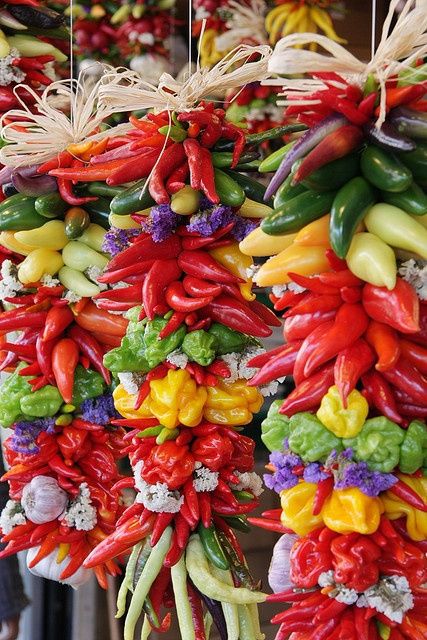
* * *
MORE SALSA!
Of course you can make the salsa described in the book (recipe steps requiring adult supervision are marked with *asteriks*), but just in case you prefer exact measurements of ingredients, here are recipes for Restaurant Style Salsa, Classic Roasted Salsa, and Salsa de Molcajete.
If you don’t have a molcajete, you can use a food processor for both the Restaurant Style Salsa and the Classic Roasted Salsa. Roasting the vegetables before blending intensifies their flavor, an added bonus in the depths of winter when those juicy red summer tomatoes aren’t available. The Classic Roasted Salsa video shows just how easy it is to make. (Click on the photos to access the recipes.)


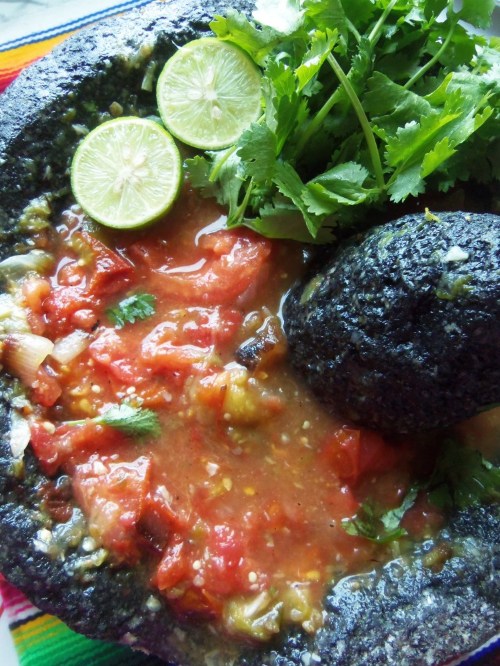
* * *
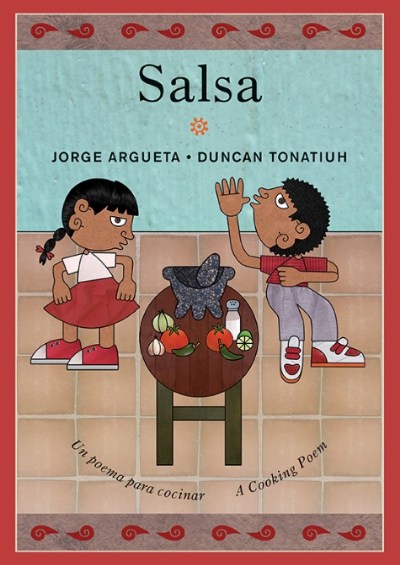
SALSA: Un poema para cocinar/A Cooking Poem
written by Jorge Argueta
illustrated by Duncan Tonatiuh
translated by Elisa Amado
published by Groundwood Books, March 2015
Bilingual Picture Book for ages 4-7, 32 pp.
*A Junior Library Guild Selection*
*Starred Review* from School Library Journal
Collect them all:
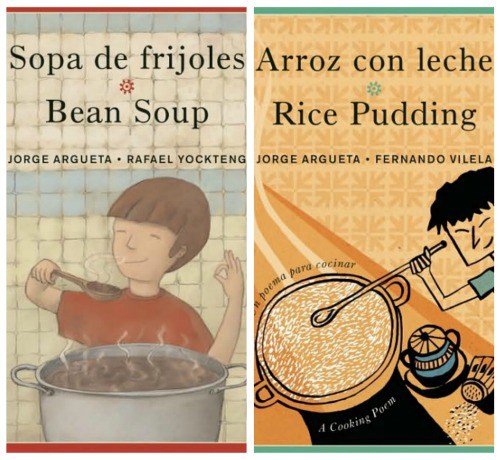
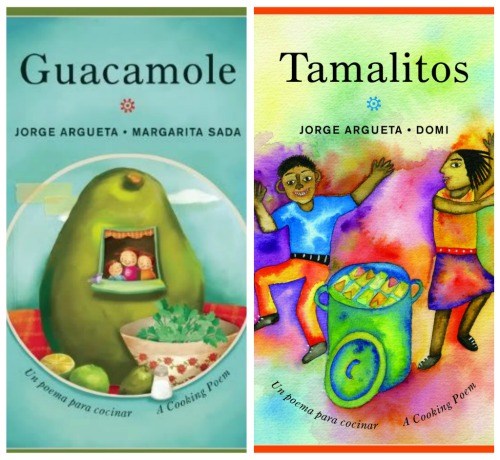
* * *
 The lovely and talented Heidi Mordhorst is hosting the Roundup at My Juicy Little Universe (she’s also hot stuff!). Salsa on over and check out the full menu of poetic goodness being served up in the blogosphere this week. 🙂
The lovely and talented Heidi Mordhorst is hosting the Roundup at My Juicy Little Universe (she’s also hot stuff!). Salsa on over and check out the full menu of poetic goodness being served up in the blogosphere this week. 🙂
———————————
*Spreads from Salsa posted by permission of the publisher, text copyright © 2015 Jorge Argueta, illustrations © 2015 Duncan Tonatiuh, published by Groundwood Books. All rights reserved.
**Copyright © 2015 Jama Rattigan of Jama’s Alphabet Soup. All rights reserved.

Love it! Even though I’m a hot pepper wimp. 🙂
LikeLike
Really? I’m surprised. 🙂
LikeLike
(I’m a hot pepper wimp, too, Kate!) This looks like another amazing addition – and those illustrations! Well, the poems (“There are purple chilies/
that look like they swallowed the sunset”), the art, everything about this book seems inspired. Such power in ancestors, music, sun – and hot peppers!
LikeLike
So much richness in this book and I’ve been enjoying all the different illustrator selections for Jorge’s recipe poems. I think I should have taken Spanish instead of French in high school — much more practical.
LikeLike
Yum to both the salsa poetry and recipes (although I too am a mild-kind-of gal.)
LikeLike
Luckily if we make our own salsa we can control the hotness :). Being mild shouldn’t stop your dancing, though!
LikeLike
I love reading the Spanish. This sounds like another great book. I’ve read at least one other thanks to your recommendations.
LikeLike
They’re all wonderful — I hope he’s working on another one :)!
LikeLike
I really love the extended musical metaphor… I will think of trumpets next time I press garlic. 🙂 My most favorite salsa is from a restaurant called Chuy’s. I found the imitation recipe online… it uses serrano peppers instead of jalapeno. Yum! Thank you for sharing, Jama! xo
LikeLike
Don’t know that I’ve ever tried serrano peppers — I think one of the recipes I linked to calls for a combo of serrano with jalapeño. Or maybe it was habanero. I like making music in the kitchen :).
LikeLike
“we turn into fireflies”–fantastic! Salsa is big at our house. Our last name is Salas and gets mistyped (by me) all the time as Salsa. My husband eats gallons of salsa. And we are taking salsa dance classes—I love it:>) Goooooo,salsa!
LikeLike
Oh, salsa dancing! You must make a video and show us :)!!
Salas’s salsaing! A spicy couple!
LikeLike
Salsa – a taste of the Southwest! My family eats a lot of salsa. In fact many Mexican restaurants here in Tucson have salsa bars where you can load up on a variety of flavors. My oldest daughter loves Mango salsa.
I love Argueta’s description from his poem: “There are purple chilies
that look like they swallowed the sunset,” Beautiful…and delicious. =)
LikeLike
That’s probably my favorite line in the book! I have a new appreciation for different types of peppers now — didn’t realize there were so many beautiful colors. I like mango salsa too — good on broiled fish :).
LikeLike
Yum! Rethinking chinese food tonight. I especially loved that chilies poem– the fireflies, grandfather and grandmother’s faces, the swallowed sunset. Bring on the salsa!
LikeLike
The chilies was my favorite part too :).
LikeLike
Hot stuff indeed–I like the hot green chilies turning us into fireflies! Funny–I can’t do spicy hot chilies and I’m not such a fan of the edible salsa…but did you know that I’m a pretty accomplished salsa dancer? Don’t get enough chances these days, but once upon a time I even danced with a performance group!
I love it that Jose Argueta has used a different illustrator for each book–keeps the series from being too repetitive. Thanks, Jama!
LikeLike
I didn’t know about your hidden salsa dancing talent, Heidi! Wow, that’s very cool :). Make a video and show us!
I’m enjoying the different illustrators too — interesting to compare how they interpret Jorge’s words.
LikeLike
Wonderful! Thanks for sharing the poems. I had to go back and read the “chilies” poem several times because it spiced up my day 🙂 Love it!!! The first stanza is my fave!
LikeLike
Those chilies are winning everyone over today — they’re not called hot stuff for nothing. 😀
LikeLiked by 1 person
Dear Jama, thank you so much for this delicious article. I hope you all your readers have a great salsa day.
LikeLike
Love the book, Jorge!! Honored to share it on the blog today. 🙂
LikeLike
I love this! “This salsa makes me feel like a salsa dancer.” I may never think of salsa quite the same again. I love the Mayan-style illustrations, too, especially the one with the little lines off the tongue showing the spicy heat.
LikeLike
Yes, those little lines — also love the musical notes/the salt — Duncan added some fun touches.
You do know what this means, don’t you? From now on, whenever we eat salsa, we have to dance salsa!
LikeLike
Now there is so much yumminess here, I now have a craving for Mexican food, and we just ate at Baja Fresh last night! I know what you mean about reading poetry out loud in Spanish – I do the same thing with Chilean poet Pablo Neruda’s poems. Will definitely be on the lookout for this series of books. They all look delectable.
LikeLike
Each book in the series has something fun and interesting to offer. Together, they are quite a satisfying meal. It’s a wonderful way to learn Spanish too. 🙂
LikeLike
I can’t remember what you reviewed before, but I did get the guacamole book, just wonderful. So glad you’ve shared the next one, Jama. Our Spanish teacher is doing a ‘food’ course at school for the older students. She will love these. Thanks, and enjoy the spice!
LikeLike
Yes, I did the guacamole book, the rice pudding, and the one before this, Tamalitos. This sounds perfect for the Spanish teacher!!
LikeLike
What a beautiful book! The language, the illustrations, the subject matter. I want to get these for our school library.
LikeLike
You should — it’s a fabulous series!
LikeLike
Salsa for breakfast? That’s what it’s going to be after reading these poems this morning! I also love the explosion of color in the photo of those chilies. Quite a contrast to the view outside my window. Thanks for sharing this today, Jama!
LikeLike
Chilies to warm us all up :)!
LikeLike
I am wowed by the illustrations! At the risk of being repetitive, my favorite is the chiles section too 🙂 I like lots of garlic in my salsa. Yum!
LikeLike
Sounds like you have a large trumpet section in your salsa orchestra. 😀
LikeLike
!Que rico!
LikeLiked by 1 person
Now you have my tastebuds doing a dance for some salsa, Jama. Love this: “and the cilantro is the orchestra conductor
with his shaggy, green hair.”
So true, somehow cilantro brings it all together in any dish that calls for a splash of it.
LikeLike
Yes, isn’t that conductor the coolest? I love cilantro :).
LikeLike
Salsa is so easy to make it is amazing we buy it ready made so often. Cute post.
LikeLike
Unbeatable with garden fresh summer tomatoes!
LikeLike
That looks fun and terrific. I love the illustrations!
LikeLike
Fun and delicious!
LikeLike
I am SO glad we are having Mexican tonight, salsa is absolutely delicious 😀
Cheers
Choc Chip Uru
LikeLike
What a coincidence :)! Enjoy! Don’t forget to salsa in the kitchen.
LikeLike
I love that the book is bilingual. The illustrations are awesome and I love fresh salsa! What a winning combination! 😀
LikeLike
Yes, with bilingual books you get two meals in one. 🙂
LikeLike
Mas salsa, por favor. Sharing the love of literacy and language through dos idomas is excellent. Perhaps you have heard of this saying, “El que habla por dos idiomas vale por dos.” I love the delightful illustrations. ~Suzy Leopold
LikeLike
Love your Spanish! You must see this book in person. 🙂
LikeLiked by 1 person
You always find gems, Jama, and then compose gems about the gems. Thanks.
LikeLike
And thanks to you, a gem of a blog reader :)!
LikeLike